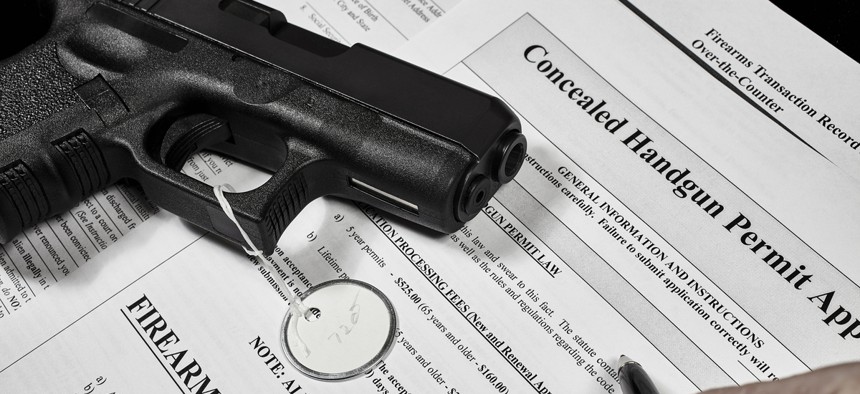Deaths Attributed to Those With Concealed Carry Permits Tracked in New Report

The report documents 1,104 incidents in 40 states and the District of Columbia that resulted in 1,335 deaths since 2007 Shutterstock
Researchers found 1,335 deaths in the past twelve years, spread across 40 states.
The number of U.S. adults with concealed carry permits has grown steadily over the past few years, with an estimated 1.4 million new permits issued in 2018. Florida hit a new record this year as the first state to pass 2 million permits issued.
Gun rights advocates say that concealed carry permit holders increase public safety, but some are now concerned with the growth of hidden firearms. A new report published by the Violence Prevention Center, a research organization that advocates for gun reform, tracks deaths attributed to those with concealed carry permits since 2007.
The report documents 1,104 incidents in 40 states and the District of Columbia that resulted in 1,335 deaths since 2007. In the majority of the incidents, the permit holder committed suicide, either alone, or after shooting other people. In 379 incidents, the person was convicted, usually of homicide. Of the 72 cases included that are pending, 59 people have been charged with homicide. A small number of incidents were unintentional fatalities caused by a gun owned by someone with a concealed carry permit, sometimes involving children.
Kristen Rand, the legislative director of the Violence Policy Center, said that because states aren’t required to publish data on deaths attributed to concealed carry permits, the incidents in the report are pulled from news searches, legal documents, and the few states with databases. “We’re looking at the tip of the iceberg. This is likely a small fraction of the overall incidents,” she said.
Of the few states tracking data, all are approaching the issue from a different angle. Michigan monitors suicides committed by concealed carry gun owners, Texas tracks convictions, and Minnesota notes justifiable uses of concealed carry guns.
The states with the most deaths were Florida with 84, Texas with 65, Ohio with 47, and Washington with 21.
All 50 states have laws in place to allow concealed carry, though the process and level of difficulty in obtaining a permit varies. Most states are “shall issue,” meaning that if an applicant meets certain requirements, like passing a background check and completing gun training, they are automatically granted a permit. Other states, and some cities, are “may issue,” meaning law enforcement has discretion to deny a permit for various reasons, such as if they believe an applicant lacks a compelling reason to carry a gun. Sixteen states do not require a permit for concealed carry.
Some studies have found that states with less stringent requirements for concealed carry permits have average rates of homicide committed with handguns 11% higher than those with rigid requirements.
The Violence Policy Center report found 41 incidents where a killing was ruled justifiable by self defense, a number which is excluded from the final death total. One recent study found that individuals with guns successfully defended themselves in less than 1% of crimes.
The data also shows 24 law enforcement officers have been killed by people with concealed firearms. Not all were in the line of duty when they were killed, but Rand said many in law enforcement are in favor of more discretion in the issuing of permits. She pointed to Iowa, where many sheriffs spoke out when the state adopted a “shall issue” stance in 2017, taking away the discretion of law enforcement to deny concealed carry permits. One sheriff said the change forced him into uncomfortable situations. “There are people out there that I know I am issuing permits to, that the law forces me to, that shouldn’t have a weapon,” Linn County Sheriff Brian Gardner told the Des Moines Register.
The International Association of Chiefs of Police is in favor of states setting their own concealed carry laws, but says that “the responsibility of carrying a concealed weapon should include a minimum of familiarization and training with the weapon carried, basic instruction on the fundamentals of carrying a concealed weapon, and understanding of when the use of a concealed weapon is legal and/or advisable.”
The Violence Prevention Center has been tracking this data for years, and has faced pushback over some of its numbers. In a review of their concealed carry data in 2014, John Lott of the Crime Prevention Research Center, a group that advocates for gun rights, noted that the inclusion of suicides was misleading. Many of the suicides included in the data come from Michigan, which tracks suicides by concealed carry permit owners, but not the method they used. “We don’t know if they committed suicide with a gun and if it was a gun, that it was the gun that they carried concealed,” Lott wrote. “Given that the overwhelming majority of these suicides were presumably at home, like the vast majority of suicides, it isn’t even clear why a concealed handgun permit is relevant.”
About 22,000 suicides each year involve a firearm, making up half of all suicide deaths.
Some suicides involve mass shooters. The report found 35 recorded cases of concealed carry permit holders committing mass shootings, resulting in 167 deaths, which Rand said is one of the most concerning findings in the database.
“I think it’s an indictment of the whole philosophy of concealed carry,” she said. “The idea is that if you arm a good guy with a gun, you can stop a bad guy with a gun. But that’s not always the case.”
Emma Coleman is the assistant editor for Route Fifty.
NEXT STORY: California Is Becoming Unlivable






